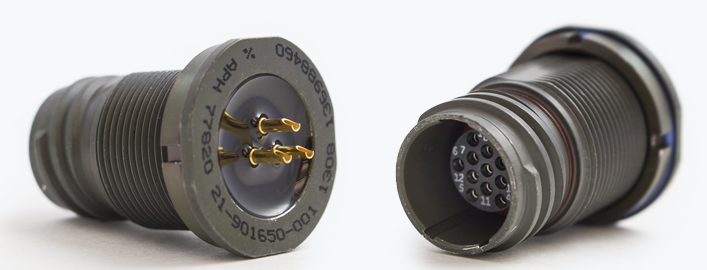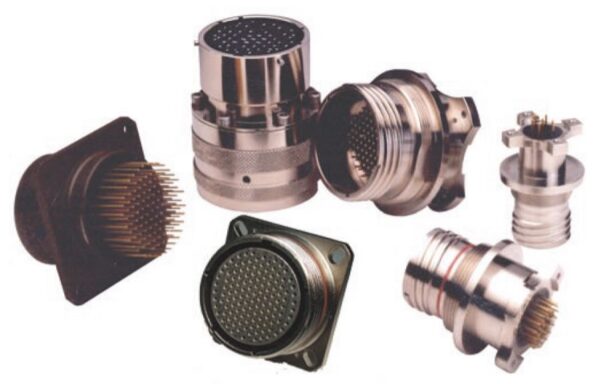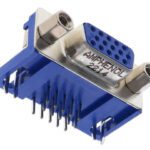What are EMI/EMP connectors?
Meet the Connector: EMI/EMP Connectors
EMI/EMP connectors, also called filter connectors, help protect electric and electronic systems from emitting or receiving disruptive “noise,” including radio frequency interference (RFI), electromagnetic interference (EMI), electromagnetic pulses (EMP), voltage spikes, and other radiated emissions that can distort or interrupt a signal. EMI, EMP, and RFI commonly occur in environments where multiple electrical and electronic modules operate in proximity. Interference emitted by a module can negatively impact other nearby systems or equipment. Emissions may escape or enter an electrical or electronic system via inputs, outlets, and other points of connection (also called line-of-sight openings).
The use of EMI and EMP filter connectors is an effective strategy to achieve electromagnetic compatibility (EMC), a state in which a module has limited radiated emissions, and also has “immunity” (or minimizes “susceptibility”) from noise emitted from other modules. Selecting EMI/EMP connectors is only one step in designing a system that achieves optimal signal performance and EMC. Multiple grounding, shielding, and filtering strategies work in tandem to meet this goal.
EMI/EMP connectors typically contain an integrated filtering element such as a capacitor within the connector housing. Capacitor types used in these connectors include a multi-layer ceramic chip (MLCC) capacitor, a tubular capacitor positioned around the connector pin, and a planar capacitor array, a barium-titanate ceramic disc or rectangle that provides a common substrate for capacitance on each pin of a connector. Inserts, often made from rubber, silicone, or elastomer, may also be used to add EMI filtering to standard products. Some products integrate high energy TVS diode technology for additional protection against direct lightning strikes or other high energy impacts.

Amphenol Aerospace’s EMI Protection Connectors have more than four decades of experience offering EMI protection in a low-weight, low-cost, micro-sized footprint.
Design Notes
Standardization
EMI/EMP connectors are available in circular and rectangular formats of many of the most common MIL-Spec connectors, including D-Subs, micro-Ds, MIL-C-26482, MIL-DTL-83723, MIL-DTL-835515, MIL-DTL-38999, and MIL-DTL-24308. Fltered rack and panel connectors include ARINC 404, ARINC 600 and MIL-DTL-83527 shell styles.

CarlisleIT’s TVS family of connectors offer EMP and lightning protection through use of a filtering embedded diode insert. These solutions can be packaged into rectangular or circular connectors and are ideal for military and commercial aircraft.
EMC regulations
The field of EMI began in 1933 when the IEC created a sub-committee to study the complications presented by radio frequency technology. CISPR (International Special Committee on Radio Interference) developed the recommended allowable emissions and immunity limits for electrical and electronic devices. Its guidelines have evolved to form the world’s current EMC regulations, which specify the acceptable limit for EMI in electrical and electronic systems. EMI/EMP connectors are an important tool that help designers meet EMC requirements in new systems.
Interference is a special challenge for critical applications in avionics and military operations. In 1967, the U.S. military issued Mil Standard 461A, which established testing and verification requirements for electronic devices already in use by the military, as well as emissions and susceptibility limits for new military electronics. In 1979, the FCC imposed legal limits on electromagnetic emissions for all digital equipment in the U.S. EMC is also a concern for medical environments. The FDA provides guidance on EMC testing and labeling for medical devices that are electrically powered or have functions or sensors that are implemented using electrical or electronic circuitry.
Accessories
Some EMC/EMP connectors are available in a modular format in which adapters or accessories are used to build a filtered connector.
Additional EMC performance improvements can be achieved with the use of banding backshells, conductive gaskets, grounding studs, feed-thru filters or filter modules, reflecting and absorbing materials, voltage suppression, and shielded cable.
Markets, Sectors, and Applications
Filtered connectors address the high-reliability needs of military and aerospace, medical, automotive, and transportation, precision audio, and any application where multiple electronic modules exist in proximity and EMC is critical to performance.

Smiths Interconnect’s filter connector series includes EMI/ EMP/ESD circular, ARINC, D-subminiature, and micro-D connector styles.
Suppliers
Amphenol Communications Solutions, Amphenol Aerospace, Cinch Connectivity Solutions, CarlisleIT, EDAC, Glenair, HARTING, ITT Cannon, Molex, Smiths Interconnect, TE Connectivity, APITech, Conesys, Cristek, EESeal (available from Heilind Electronics), Filconn (available from PEI Genesis), Glenair, Souriau (available from TTI Inc.)
Related products:
- Shielded cable
Like this article? Check out our other Meet the Connector, Power Connectors, and our Transportation Industry Page, and our 2022 Article Archive.
Subscribe to our weekly e-newsletters, follow us on LinkedIn, Twitter, and Facebook, and check out our eBook archives for more applicable, expert-informed connectivity content.
- Where in the World is Amphenol LTW’s Luc Kan? - April 23, 2024
- TE Connectivity’s Sustainability Efforts Pay Off - April 23, 2024
- What is a VGA Connector? - April 23, 2024





